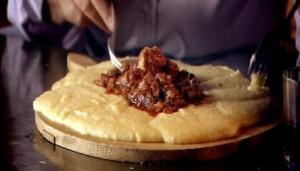I picked up 2 bottles of these back in 2009 already with a bit of bottle age on them. According to my notes I paid $35 a bottle for them, so with the age and the price I was expecting something pretty interesting and I paired them with a nice home cooked dinner and a good friend.
I was quite taken by the BBC series (shown here in Australia on SBS) Two Greedy Italians. Chefs Antonio Carluccio and Gennaro Contaldo aren’t really Italian, but they are Australians who were born in Italy. In this series they return home to cook local meals and meals from their childhood. So for dinner last night I prepared polenta with slow cooked family stew. While probably not the most inspiring name, the food was great. You can download the recipe here (http://www.bbc.co.uk/food/recipes/slow-cooked_family_stew_33263). While at the BBC site, I downloaded this recipe and also made the Lemon and Ricotta Tart (http://www.bbc.co.uk/food/recipes/lemon_and_ricotta_tart_44080). I didn’t have any Juniper berries, so I just added a little extra Rosemary (fresh from the garden) and I cooked the stewfor close to 5 hours until the meat was absolutely tender.
But back to the wine. The 2002 Marqués de Cáceres Rioja Reserva is a blend of 85% Tempranillo and 15% Garnacha Tinta and Graciano. They seem to sell their stock only after 5 or 6 years bottle age (which accounts for how I bought this 2002 vintage in 2009). The cork was almost brand new and the wine pour bright red despite its age. It started tight (served at 15 degrees) and tasted of dried fruits, tobacco and vanilla oak. It was soft and smooth with tannins that may have been improved by better quality oak. At $35 I didn’t find great value, but on some international wine sites I’ve seen this for close to the $20 mark and at this price it holds more appeal.
I have one bottle left in the cellar. I’ll probably try it with a simpler dish and with plenty of time to breath.
Here’s some other notes I’ve found:
winemaker’s notes:
Dark, ruby red color. Dense bouquet combining toasted notes, tobacco and a hint of spice. Good structure with nice complexity in the mouth where mature fruit flavors give way to a touch of roasted coffee, chocolate and sweet spice. A wine full of character that reflects its noble origin.
A splendid bottle to marry with savoury fish dishes such as fresh tuna in spicy tomato sauce, refined delicatessen products (chorizo, salami), all kinds of beef (roasted, stewed or grilled), foie gras, duck, partridge, game and mature cheese. alcohol by volume: 13.0%
Stephen Tanzer’s International Wine Cellar write :
Bright red. Complex bouquet of dried strawberry, cherry, rose and cured tobacco. Spicy cherry and red berry flavors are sweetened by a faint vanilla quality and show no rough edges or tannins. Attractively sweet and silky Rioja with good finishing breadth and clinging notes of strawberry and dried flowers. This is ready to drink and will be ideal with spicy lamb dishes.
Some other brief notes :
Air, air, air! – A pour through the Vinturi + 20 minutes in the decanter was not enough. Give it an hour or so and it will really open up, very much enjoyed this (especially for the price), although I also still prefer the 2001.
While non-offensive, we found to be a bit boring. Probably would be a great sub $20 for a dinner party involving rich beef dishes, but for a more intimate setting where wine is the focus would not suggest.
Great balance which stayed all the way through to the aftertaste. currants and subtle cherry, medium body with ruby red colour.








